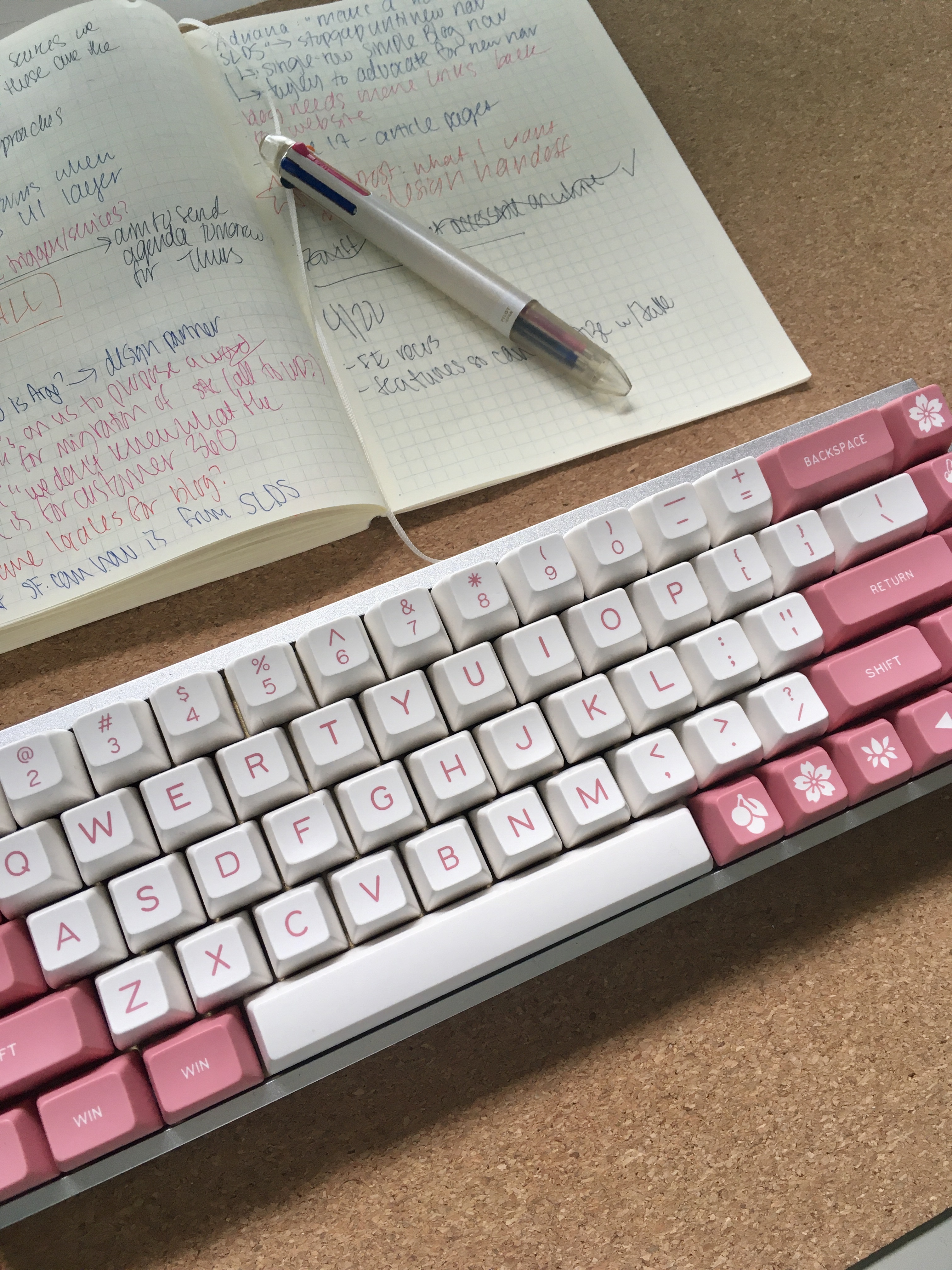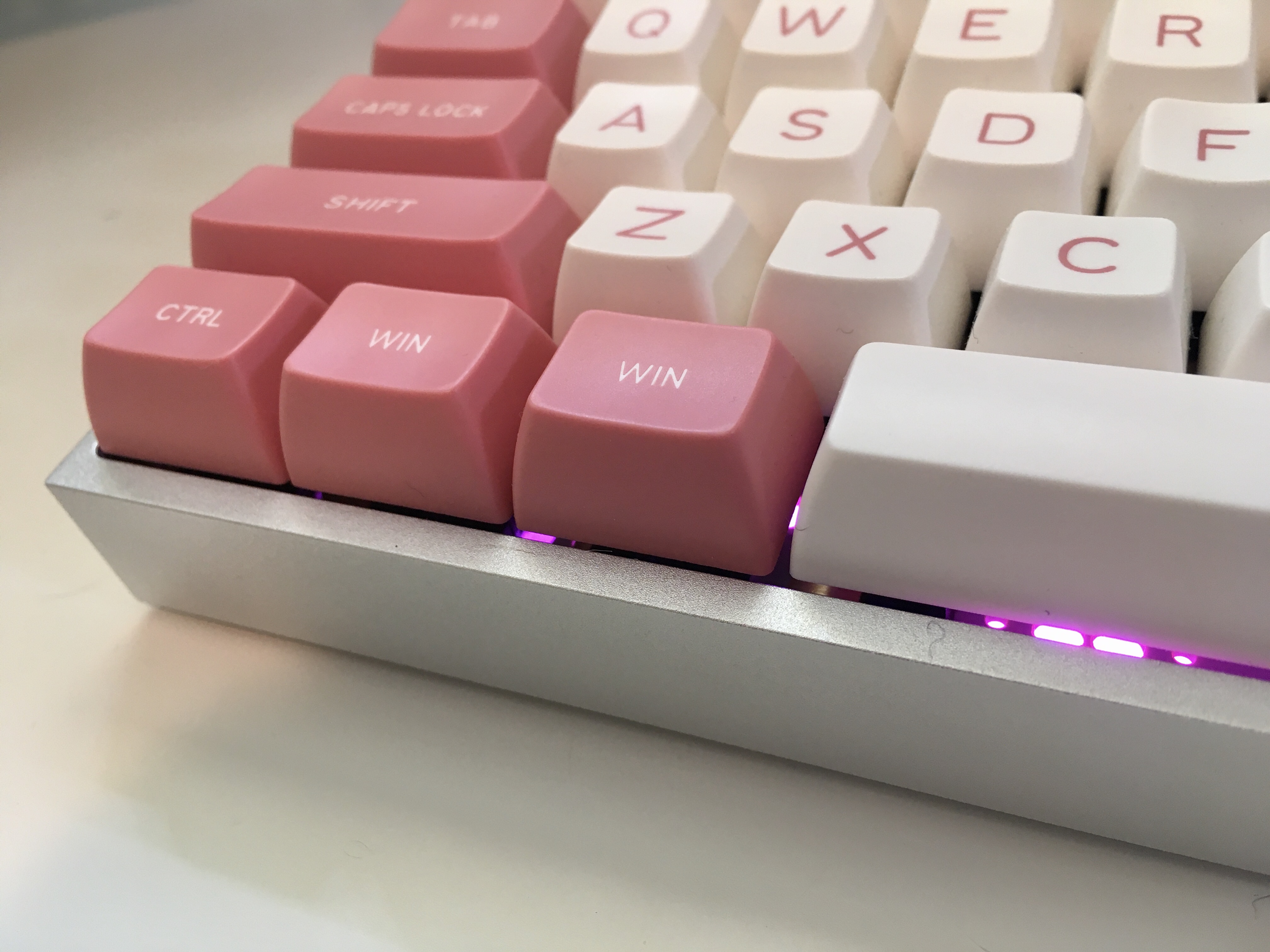How To Get Hex File From Qmk Configurator
A few months agone, after a full twelvemonth of waffling, I bought my first custom keyboard. During the setup process, I felt similar most of the tutorials I was finding were geared towards people knowledgeable about keyboards and less familiar with programming in full general. I'm exactly the opposite of this -- over 10 years' cumulative feel programming, only picayune knowledge of keyboards and their workings.
Because of this, I kept notes every bit I customized my keyboard layout. Hither'south what I did, and I hope information technology helps you get started with your ain custom setup 🤓

My keyboard. What a beaut!
Why a Custom Keyboard?
I became interested in custom keyboards for aesthetic reasons. I was used to toggling between a chunky dark grey keyboard (when on a PC) or a slim silvery one (for a Mac). Either mode, keyboards were uniform and. Learning that there was some other path -- of personal investment, care, and customization -- was intriguing to me.
Cost was my largest blocker to actually ownership a keyboard. The first custom keyboards I was linked to ran about $400; the kit I actually bought totaled $340. This is a lot of money, simply I planned to employ the keyboard for work. $400 for a tool I would utilise 40+ hours per week, I figured, was actually a reasonable expense when all was said and done.
The Kit
On the advice of a coworker, I bought a Tofu65 assembled keyboard from KBDFans.com.
I chose Cherry Silent Black switches (to be considerate to officemates -- what innocent times those were). For keycaps, I found a pink-and-white Maxkey set up that would be a joy for me to use every day.
The keyboard took about 2 months to arrive; using it was as simple equally plugging it into my reckoner's USB port. The shipment included a little wire tool for lifting keycaps off of the board, so physically rearranging keys was too trivial. The other side of this process -- configuring the keyboard firmware to send the correct signals to the calculator -- would exist more hard.
A coworker advised me that getting fix upwards to configure firmware would take a while, but would be worth the time. So I cleared my agenda ane Sabbatum forenoon, poured myself a large cup of java, and got to work.
Creating the Custom Layout
Here'southward the process I followed to create and load a custom keyboard layout. This is what was useful to me, so some of these steps diverge from what you might observe in other walkthroughs that assume more than familiarity with keyboards in general.
Download and configure the QMK Toolbox
My keyboard, like nigh others from KBDFans, is uniform with QMK firmware. Several of these side by side steps are paraphrases from the QMK docs.
Outset by installing QMK with Homebrew:
brew tap qmk/qmk brew install qmk This may have a while if Homebrew needs an update (which it ever seems to??). Don't walk away for too long, though, since at that place are some interactive prompts to install dependencies of QMK.
Side by side, fork the QMK Toolbox repo on Github and run the QMK setup control using this remote URL:
qmk setup <your_github_username>/qmk_toolbox Finally, follow QMK's customization instructions to save yourself a lot of typing.
Pattern the layout
I did all of my layout editing in the online QMK Configurator tool. The drag-and-drop interface was elementary to employ, peculiarly since I don't know much near the underlying processes. QMK has a expert video intro to the configurator; I'll deviate from it in that I used QMK from the control line, not from a GUI.
Select the keyboard
Choose your keyboard type from the dropdown at the top of the configurator.
In my case, my keyboard (kbdfans/kbd65) isn't actually in the listing of available keyboards in the QMK Configurator, just information technology is supported nether the name kbdfans/kbd67. This keyboard defaults to the LAYOUT_65_ansi layout which matched my keyboard perfectly.
Pattern the layout map
This is the fun office! Drag and drop keys to where y'all really want them. I won't get into using multiple layers, or whatever actual C programming 😅 It's very 1337 simply not what I needed my first time around.
Download the layout
Since you already have the keyboard firmware installed, once yous have your map made in the QMK Configurator, y'all can hit the Download Keymap.json button without compiling the layout. From now on you'll exist working completely in the control line, but keep this browser window open up for follow-upwardly tweaks to the layout.
Flash the layout onto the keyboard
Your keymap needs to be compiled in lodge to be flashed onto the keyboard. Locate the JSON file downloaded from the QMK configurator, and run:
qmk compile <path/to/downloaded/layout>.json If successful, QMK volition output a .hex file into its root directory. For me, this was at Users/<my_username>/qmk_firmware.
Adjacent, the keyboard needs to be put into DFU/Bootloader way in order to exist flashed. While in Bootloader fashion, it will not send inputs to your computer like it normally does. If your keyboard underlight is on, the lite will turn off when the board goes into Bootloader mode.
Keyboard vary in how they can exist sent into Bootloader mode. QMK has instructions on different ways to practise this — the first fourth dimension I flashed my keyboard, the Spacebar+B strategy worked. Subsequent times, this didn't work, but unplugging my keyboard and plugging it back in with the ESC key pressed did send it into Bootloader mode correctly.
With your keyboard in Bootloader mode, run qmk flash on the command line to send your layout onto the keyboard. Don't unplug the keyboard until you lot become a message that the flash has completed. Now your keyboard is using your custom layout! 🎉
You can flash your keyboard as many times as y'all desire to. I flashed mine virtually ten times during that session as I honed what I really wanted my keyboard to do.
The effect
In the cease, I take a keyboard that is completely tailored to what I want, and it feels glorious. In addition to a total keyboard, I take dedicated play/pause and volume upwardly/downwards buttons. The volume buttons also let me skip tracks when paired with a modifier cardinal 💅🏻 And, naturally, I have a couple of keys dedicated to toggling the keyboard underlight.

All in all, the fourth dimension and money I've invested in this keyboard has felt worth information technology -- because it has truly felt like an investment. I honey having tools that feel good to use, that piece of work well, that feel familiar to me. I've been using this keyboard for about a month now; it's a petty puff of current of air in my sails whenever I sit downward to work, and I look forward to many years with it.
Thank you
Beginning, thanks for reading this far, and I hope it'south been helpful!
Thanks to Jordan Egstad for being an endless font of keyboard inspiration & cognition. Also, thank you for letting me borrow your "starter keyboard" for 😅 months 😅 every bit I decided what I was actually going to purchase.
Thanks also to Angela Riggs for additional keyboard intel, such as encouraging me to take my fourth dimension setting up my dev surroundings.
Source: https://vgpena.github.io/qmk/

0 Response to "How To Get Hex File From Qmk Configurator"
Post a Comment